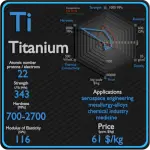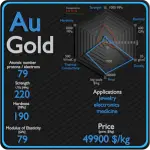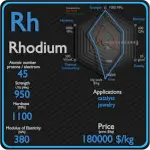This article contains comparison of key thermal and atomic properties of copper and silver, two comparable chemical elements from the periodic table. It also contains basic descriptions and applications of both elements. Copper vs Silver.

Copper and Silver – About Elements


Source: www.luciteria.com
Copper and Silver – Applications
Copper
Historically, alloying copper with another metal, for example tin to make bronze, was first practiced about 4000 years after the discovery of copper smelting, and about 2000 years after “natural bronze” had come into general use. An ancient civilization is defined to be in the Bronze Age either by producing bronze by smelting its own copper and alloying with tin, arsenic, or other metals. The major applications of copper are electrical wire (60%), roofing and plumbing (20%), and industrial machinery (15%). Copper is used mostly as a pure metal, but when greater hardness is required, it is put into such alloys as brass and bronze (5% of total use). Copper and copper-based alloys including brasses (Cu-Zn) and bronzes (Cu-Sn) are widely used in different industrial and societal applications. Some of the common uses for brass alloys include costume jewelry, locks, hinges, gears, bearings, ammunition casings, automotive radiators, musical instruments, electronic packaging, and coins. Bronze, or bronze-like alloys and mixtures, were used for coins over a longer period. is still widely used today for springs, bearings, bushings, automobile transmission pilot bearings, and similar fittings, and is particularly common in the bearings of small electric motors. Brass and bronze are common engineering materials in modern architecture and primarily used for roofing and facade cladding due to their visual appearance.
Silver
Silver has long been valued as a precious metal. Silver metal is used in many bullion coins, sometimes alongside gold. Silver has many important, far-reaching technological and electronic applications. It’s used in everything from cell phones, computers and semiconductors to automobiles, water-purification systems and—because it is the best conductor of heat of all elements—spacecraft solar radiation tiles. Silver is of the upmost importance in photography (where approximately 30% of the U.S. Industrial consumption goes into this application). The medical uses of silver include its use in wound dressings, creams, and as an antibiotic coating on medical devices. Wound dressings containing silver sulfadiazine or silver nanomaterials may be used on external infections.
Copper and Silver – Comparison in Table
| Element | Copper | Silver |
| Density | 8.92 g/cm3 | 10.49 g/cm3 |
| Ultimate Tensile Strength | 210 MPa | 110 MPa |
| Yield Strength | 33 MPa | 45 MPa |
| Young’s Modulus of Elasticity | 120 GPa | 83 GPa |
| Mohs Scale | 3 | 3.25 |
| Brinell Hardness | 250 MPa | 210 MPa |
| Vickers Hardness | 350 MPa | 251 MPa |
| Melting Point | 1084.62 °C | 961.78 °C |
| Boiling Point | 2562 °C | 2162 °C |
| Thermal Conductivity | 401 W/mK | 430 W/mK |
| Thermal Expansion Coefficient | 16.5 µm/mK | 18.9 µm/mK |
| Specific Heat | 0.38 J/g K | 0.235 J/g K |
| Heat of Fusion | 13.05 kJ/mol | 11.3 kJ/mol |
| Heat of Vaporization | 300.3 kJ/mol | 250.58 kJ/mol |
















